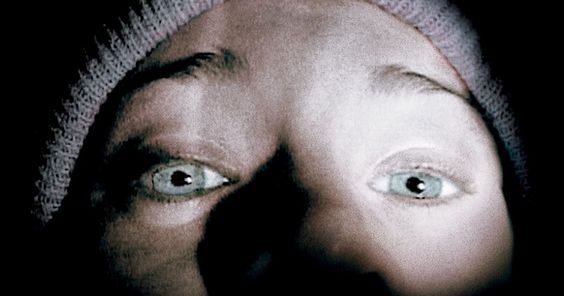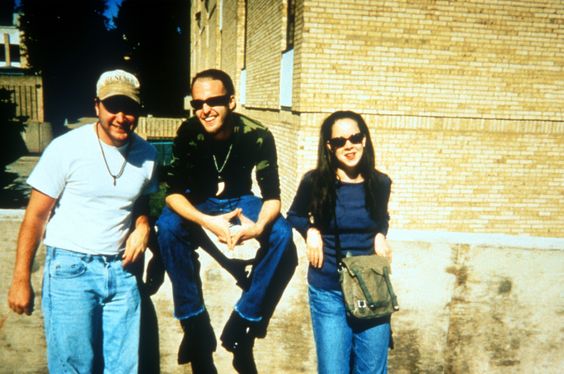|Kevin Maher|

The Blair Witch Project plays at the Trylon Cinema from Sunday, October 22nd, through Tuesday October 24th. Visit trylon.org for tickets and more information.
The pitch for The Blair Witch Project, the 1999 summer box office phenomenon and viral marketing sensation, is as simple as the finished movie actually turned out to be. “Student filmmakers go into the woods to make a documentary, disappear, and their footage is found,” certainly relays the basic tenants of the story; but ultimately it’s everything else that swirled around the film that made it interesting then, forever part of the lore of independent filmmaking and makes it worth talking about 24 years later. As an employee of Artisan Entertainment, the film distribution company that purchased and released the film, my perspective is a little different. Looking back to those days of VHS and DVD reminds me of just how unique The Blair Witch Projectreally was.
For a film that cost just $22,000 and took 8 days to shoot, The Blair Witch Project had a lot going for it before it was accepted to screen at the 1999 Sundance Film Festival. The film was a four-year dream of co-directors Daniel Myrick and Eduardo Sanchez who, as students at Central Florida University, crafted an intricate back story for the Blair Witch that extended from the colonial era through the 20th century. They also shot a second feature-length film that was supposed to be tied into The Blair Witch Project, but was scrapped, then released as The Curse of the Blair Witch on the DVD after the feature film exploded.
The filmmakers made the intelligent decision to utilize this backstory to seed a website, suggesting that the lost footage had been found, then exploiting early interest by releasing clues and evidence of the missing filmmakers’ disappearances and the backstory of the witch. Fueled by nascent internet chat rooms and message boards, the idea of the missing filmmakers and the myth of the Blair Witch became intertwined. The break that brought about larger notoriety came when the IFC channel’s independent film series Split Screen aired a segment about the found footage as part of their 1997 season finale. Site traffic and viewer interest became so strong that Split Screen presented another segment in August of the same year, with both focused on the mythology of the Blair Witch and the idea of the found footage, but nothing was ever shown of what would become The Blair Witch Project. In fact, shooting on the actual feature wouldn’t even start in the woods of Maryland until October 1997.

Despite a national cable platform, the team at Haxan, the production company formed by Myrick, Sanchez, and a group of Central Florida students and graduates, would take nearly two years to bring The Blair Witch Project to the attention of programmers at the Sundance Film Festival, the preeminent independent film festival during the indie boom of the 1990s. During the intervening years, the group created physical artifacts, conducted ‘expert interviews,’ and expanded the mythology, all with the intention of extending the film beyond the footage that ultimately became the final product. Disappointments were many, money was short, and the inexperience of the group led to many fits and starts as they attempted to assemble their material into a coherent story. Finally, they admitted that the film they wanted was “discovered in the edit”1 and they submitted it for consideration for festivals in the fall of 1999. With Sundance as the goal, they used meager connections to forge a relationship with Endeavor Talent agency and to hire several lawyers and a Hollywood pitchman to seek out additional funding.
When Sundance finally agreed to include the film, they did so with several caveats that initially upset Haxan, but ultimately paid enormous dividends once the festival launched. The first challenge was the offer of a midnight screening, which was generally the landscape littered with offbeat genre pictures at the festival. The second caveat was to exclude the film from the dramatic category, instead leaving it out of competition, but without the designation of being either fiction OR non-fiction. Finally, the festival offered three screenings, which in itself is good, but for Haxan meant off-times in small theaters. They nonetheless accepted the offer and utilized the opportunity to secure funding to transfer their 16mm and HI-8 video shot movie to be blown up onto 35mm film, which took until just two weeks before the festival began.
This was when things started to get interesting. Building off the guerilla marketing that served them throughout the production process, Haxan was determined to extend the same kind of tactics on the streets of Park City, Utah. By plastering every vertical object with posters identifying the ‘missing’ filmmakers from the found footage, peppering every bar with beer coasters with the ‘stickman’ logo, and identifying themselves only with stickman logo lapel pins, the group created a buzz leading up to the first Saturday night midnight screening. While the screening sold out, the evening had just begun: several major distributors, including indie king Miramax, were in attendance and interested in meeting with Haxan the next day.
While the group went back to their condo to celebrate, however, things took a turn. Artisan called at 3 A.M. to begin negotiations to purchase the film, expecting to get a jump on their competitors. They were an up-and-coming distributor buoyed by a deep catalog of classic movies that they exploited for capital on VHS and DVD. The prior year they had made a splash by releasing Darren Aronofsky’s first feature Pi, which grossed more than three million dollars at the box office. When a deal was finally struck at 6 A.M., it included not only a platform theatrical release but $1.125 million for Haxan. Most importantly, if the film grossed more than $10 million, Artisan would owe Haxan 75% of the gross box office less Artisan’s 25% distribution fee and any expenses it incurred. The deal reflected both Artisan’s desire to sign the film and an amazing underestimation of the tidal wave that would wash over everything before the 25-city limited opening on July 16th and national opening on July 30th.
Within a week of the Sundance purchase, Artisan showed the film to some employees, myself included, at a midnight screening at a desert resort. Not sure what to make of the film, which had developed an ‘is it real?’ conspiracy, several staffers were alarmed to discover piles of rocks outside their patio doorways and stick figures along a walking path. The mythology was real. The marketing had just begun and the decision to feed the machine by keeping doubt sewn in everyone who encountered or talked about the film helped word of mouth. Artisan also chose to keep the rudimentary website that Haxan had created alive and sprinkled more information to further discussions and theories.
All through the spring and summer, Artisan insiders were barraged with questions about the film. Nothing compared to the onslaught that arrived when it opened on 27 screens on July 16th and grossed $1.5 million, before expanding two weeks later and grossing another $29.2 million. Within 16 days, the film had destroyed the ceiling of payments in Haxan’s deal with Artisan and opened up an enormous can of financial worms at Artisan, while also creating a life-changing reality for the gang at Haxan. But the devil is always in the details and in Hollywood, the detail in the clause ‘less expenses incurred’ was something the Haxen group overlooked.
Everyone knows the story that Forrest Gump didn’t turn a profit until nearly a decade after it enjoyed its $678 million worldwide gross, done in by Hollywood accounting. Though it wasn’t immediately apparent, The Blair Witch Project would make this process crystal clear. After Blair Witch triggered those enormous box office dollars and imminent payments to Haxan, everything the company did seemingly became a Blair Witch expense. 25% company-wide bonus in August, sales meetings on California coastal resorts, an elaborate (and I mean elaborate) Christmas party, and just about anything else you could think of was magically attributed to Blair Witch; tens of millions of dollars to be sure, some of which eventually flowed to the filmmakers. When all was said and done, the movie grossed more than $140 million dollars, the Haxan team was made wealthy beyond their wildest dreams, and Blair Witch cemented itself as one of the most profitable films of the 90s.
Over time, the allure of the mystery of The Blair Witch Project diminished, though Artisan still had the cash cow of home entertainment to milk before the year’s end. At that time, a $140 million blockbuster could generate tens of millions more, but it wasn’t to be. The title was an abject failure on VHS and DVD in large part because what fueled its rocket ride ascent no longer interested the viewing public. The mystery had been solved, the questions had been answered. When I watched the film last week in preparation for writing this piece, however, I was able to watch it for what it is—a great piece of marketing with a fascinating story behind it. It still resonates as a great piece of the past popular ‘found footage’ film, but it also survives as a tight, well-constructed whodunnit. I certainly enjoyed the spoils of The Blair Witch Project in 1999, and watching it again certainly reminded me how cool it was to work for Artisan, but I think more than that it’s really fun to remember when a film could come out of nowhere, with no baggage and truly surprise an audience. For that, The Blair Witch Project is worth revisiting!
- Blazi, Matt. 8 Days in the Woods: The Making of The Blair Witch Project. Independently Published, 2019. 195. ↩︎
Edited by Finn Odum
